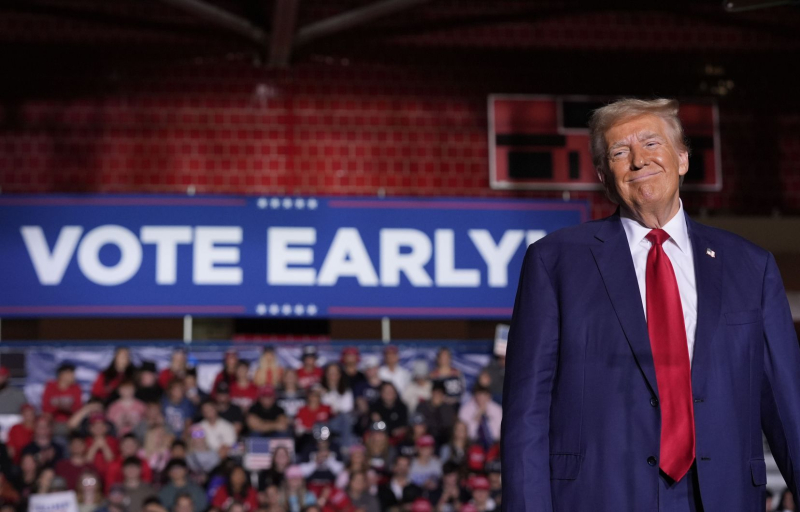
Photo: Alex Brandon Associated Press Republican presidential candidate former President Donald Trump speaks at a rally in University Center, Michigan, on October 3. Behind him is a large banner that reads “Vote Early,” a reference to early voting that has begun in several U.S. states ahead of November 5.
Nicholas Riccardi – Associated Press
Posted yesterday at 7:12 p.m.
- United States
With encouragement from former US President Donald Trump, Republicans are voting early again, with their mass return to the polls to vote in person before Election Day even helping to break voting records in key states like Georgia and North Carolina.
Campaigns typically want their voters to vote before Election Day so they can focus their resources on mobilizing fringe supporters to the polls at the last minute.
Republicans excelled at this before Donald Trump turned against mail-in voting in 2020, inventing outlandish conspiracies about the centuries-old process and persuading his supporters to wait until Election Day to cast their ballots.
Several Republicans have accused this strategy of having cost the party the 2020 presidential election and the key elections of 2022. Which the Republican Party hopes to avoid this time by once again pushing its voters to vote early, with the support of Mr. Trump who encourages the strategy with… a conspiratorial speech.
200% Deposit Bonus up to €3,000 180% First Deposit Bonus up to $20,000Last week, during a radio show hosted by the conservative Dan Bongino, who has widely spread false information about early voting and the 2020 election, the Republican candidate confided that he was telling “everyone to vote early.”
The appeal appears to be working. In North Carolina, where Democrats had a lead of more than 30 percentage points at this point in 2022, they are ahead by just 1 percentage point this year. In Nevada, where Democrats have relied for decades on robust early voting to counter the GOP on Election Day, about 1,000 more Republicans than Democrats voted early this year.
It’s hard to gauge whether these new trends will influence the outcome of the election, however. Early voting data only reveal whether voters are registered with a party, not which party they voted for. And some demographic trends that emerge during early voting can suddenly disappear once Election Day votes are counted.
Advantages that can change
The early voting process is still new—the last of the seven swing states, Wisconsin, launched its own Tuesday morning.
“Democrats continue, as far as I can tell, to accumulate more early votes. It’s just less of a disadvantage for Republicans,” says Michael McDonald, a political scientist at the University of Florida who closely tracks early voting. But, he cautions, “we don’t know yet whether this is a move of furniture or an additional advantage for Republicans.”
One thing is clear: The return to bipartisan early voting has helped break records. North Carolina and Georgia both reported record turnout on the first day of in-person early voting, and it even spilled over into states that aren’t particularly crucial to the presidential election, like South Carolina, which reported a record when polls opened Monday.
Republicans still seem to have an aversion to mail-in voting. They’ve improved their share of mail-in voting in several states, but they still lag behind Democrats, notably in Pennsylvania, where there is no in-person early voting option and Republicans have cast more than 300,000 fewer mail-in ballots than Democrats. But the GOP is catching up by voting early in person in most key states.
Yet years of conspiracies surrounding early voting and mail-in voting have taken a toll on conservative voters. At the first solo event in support of Mr. Trump last week, billionaire Elon Musk urged the crowd to vote early, a plea that some in the audience responded to by shouting, “Why?”

